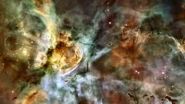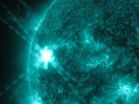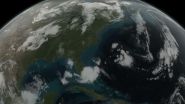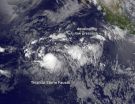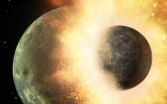(Press-News.org) VIDEO:
NASA Goddard astrophysicists Ted Gull and Tom Madura discuss Eta Carinae and their new model of the Homunculus Nebula, a shell of gas and dust ejected during the star's mid-19th...
Click here for more information.
In the middle of the 19th century, the massive binary system Eta Carinae underwent an eruption that ejected at least 10 times the sun's mass and made it the second-brightest star in the sky. Now, a team of astronomers has used extensive new observations to create the first high-resolution 3-D model of the expanding cloud produced by this outburst.
"Our model indicates that this vast shell of gas and dust has a more complex origin than is generally assumed," said Thomas Madura, a NASA Postdoctoral Program fellow at NASA's Goddard Space Flight Center in Greenbelt, Maryland, and a member of the study team. "For the first time, we see evidence suggesting that intense interactions between the stars in the central binary played a significant role in sculpting the nebula we see today."
Eta Carinae lies about 7,500 light-years away in the southern constellation of Carina and is one of the most massive binary systems astronomers can study in detail. The smaller star is about 30 times the mass of the sun and may be as much as a million times more luminous. The primary star contains about 90 solar masses and emits 5 million times the sun's energy output. Both stars are fated to end their lives in spectacular supernova explosions.
Between 1838 and 1845, Eta Carinae underwent a period of unusual variability during which it briefly outshone Canopus, normally the second-brightest star. As a part of this event, which astronomers call the Great Eruption, a gaseous shell containing at least 10 and perhaps as much as 40 times the sun's mass was shot into space. This material forms a twin-lobed dust-filled cloud known as the Homunculus Nebula, which is now about a light-year long and continues to expand at more than 1.3 million mph (2.1 million km/h).
Using the European Southern Observatory's Very Large Telescope and its X-Shooter spectrograph over two nights in March 2012, the team imaged near-infrared, visible and ultraviolet wavelengths along 92 separate swaths across the nebula, making the most complete spectral map to date. The researchers have used the spatial and velocity information provided by this data to create the first high-resolution, fully 3-D model of the Homunculus Nebula. The new model contains none of the assumptions about the cloud's symmetry found in previous studies.
The shape model, which is now published by the journal Monthly Notices of the Royal Astronomical Society, was developed using only a single emission line of near-infrared light emitted by molecular hydrogen gas. The characteristic 2.12-micron light shifts in wavelength slightly depending on the speed and direction of the expanding gas, allowing the team to probe even dust-obscured portions of the Homunculus that face away from Earth.
"Our next step was to process all of this using 3-D modeling software I developed in collaboration with Nico Koning from the University of Calgary in Canada. The program is simply called 'Shape,' and it analyzes and models the three-dimensional motions and structure of nebulae in a way that can be compared directly with observations," said lead researcher Wolfgang Steffen, an astrophysicist at the Ensenada campus of the National Autonomous University of Mexico.
The new shape model confirms several features identified by previous studies, including pronounced holes located at the ends of each lobe and the absence of any extended molecular hydrogen emission from a dust skirt apparent in visible light near the center of the nebula. New features include curious arm-like protrusions emanating from each lobe near the dust skirt; vast, deep trenches curving along each lobe; and irregular divots on the side facing away from Earth.
"One of the questions we set out to answer with this study is whether the Homunculus contains any imprint of the star's binary nature, since previous efforts to explain its shape have assumed that both lobes were more or less identical and symmetric around their long axis," explained team member Jose Groh, an astronomer at Geneva University in Switzerland. "The new features strongly suggest that interactions between Eta Carinae's stars helped mold the Homunculus."
Every 5.5 years, when their orbits carry them to their closest approach, called periastron, the immense and brilliant stars of Eta Carinae are only as far apart as the average distance between Mars and the sun. Both stars possess powerful gaseous outflows called stellar winds, which constantly interact but do so most dramatically during periastron, when the faster wind from the smaller star carves a tunnel through the denser wind of its companion. The opening angle of this cavity closely matches the length of the trenches (130 degrees) and the angle between the arm-like protrusions (110 degrees), indicating that the Homunculus likely continues to carry an impression from a periastron interaction around the time of the Great Eruption.
Once the researchers had developed their Homunculus model, they took things one step further. They converted it to a format that can be used by 3-D printers and made the file available along with the published paper.
"Now anyone with access to a 3-D printer can produce their own version of this incredible object," said Goddard astrophysicist Theodore Gull, who is also a co-author of the paper. "While 3-D-printed models will make a terrific visualization tool for anyone interested in astronomy, I see them as particularly valuable for the blind, who now will be able to compare embossed astronomical images with a scientifically accurate representation of the real thing."
INFORMATION:
Astronomers bring the third dimension to a doomed star's outburst
2014-07-08
ELSE PRESS RELEASES FROM THIS DATE:
NASA's SDO spots a summer solar flare
2014-07-08
The sun emitted a mid-level solar flare, peaking at 12:20 p.m. EDT on July 8, 2014, and NASA's Solar Dynamics Observatory captured images of the event. Solar flares are powerful bursts of radiation. Harmful radiation from a flare cannot pass through Earth's atmosphere to physically affect humans on the ground, however -- when intense enough -- they can disturb the atmosphere in the layer where GPS and communications signals travel.
To see how this event may affect Earth, please visit NOAA's Space Weather Prediction Center at http://spaceweather.gov, the U.S. government's ...
NASA-JAXA's new precipitation satellite sees first Atlantic hurricane
2014-07-08
VIDEO:
The animation begins with global infrared data showing the progression of the storm as it forms into a hurricane. Then GPM flies overhead measuring rain rates on the ground. GPM's...
Click here for more information.
The Global Precipitation Measurement (GPM) Core Observatory flew over Hurricane Arthur five times between July 1 and July 5, 2014. Arthur is the first tropical cyclone of the 2014 Atlantic hurricane season.
GPM is a joint mission between NASA and the Japan ...
Satellite sees newborn Tropical Storm Fausto being 'chased'
2014-07-08
Tropical Storm Fausto was literally born yesterday and strengthened to a tropical storm quickly. Satellite imagery from NOAA's GOES-West satellite shows a rounded Fausto being "chased" by a developing area of low pressure to the east of the storm.
NOAA's Geostationary Operational Environmental Satellite GOES-West captured a combination visible and infrared image of the Eastern Pacific on July 8 at 1500 UTC (10 a.m. EDT). In the image, Tropical Storm Fausto appeared as a rounded area of clouds, compared to the amorphous developing low pressure area behind it.
At 6:30 ...
NCI study finds extreme obesity may shorten life expectancy up to 14 years
2014-07-08
Adults with extreme obesity have increased risks of dying at a young age from cancer and many other causes including heart disease, stroke, diabetes, and kidney and liver diseases, according to results of an analysis of data pooled from 20 large studies of people from three countries. The study, led by researchers from the National Cancer Institute (NCI), part of the National Institutes of Health, found that people with class III (or extreme) obesity had a dramatic reduction in life expectancy compared with people of normal weight. The findings appeared July 8, 2014, in ...
Virtual reality crowds produce real behavior insights
2014-07-08
VIDEO:
Researchers at Brown University have developed a wireless virtual reality system to better understand how pedestrians interact with one another and generate patterns of crowd movement.
Click here for more information.
PROVIDENCE, R.I. [Brown University] —The cognitive scientists in the Virtual Environment Navigation lab at Brown University are not only advancing a frontier of behavioral research but also of technology.
Led by Professor William Warren, the group developed ...
Three reforms to protect California's cap-and-trade policy
2014-07-08
California's landmark cap-and-trade system for regulating greenhouse gases could be vulnerable to price spikes and market manipulation, according to a new study released by scholars affiliated with the Energy Institute at Haas. But the state's air-quality regulators can prevent that outcome with three straightforward reforms, the study says.
Specifically, the California Air Resources Board should consider (1) strengthening the new market's price collar—the so-called allowance price containment reserve—(2) allowing permits to be converted from one compliance period to ...
Planet Mercury a result of early hit-and-run collisions
2014-07-08
TEMPE, Ariz. - Planet Mercury's unusual metal-rich composition has been a longstanding puzzle in planetary science. According to a study published online in Nature Geoscience July 6, Mercury and other unusually metal-rich objects in the solar system may be relics left behind by collisions in the early solar system that built the other planets.
The origin of planet Mercury has been a difficult question in planetary science because its composition is very different from that of the other terrestrial planets and the moon. This small, innermost planet has more than twice ...
Using sand to improve battery performance
2014-07-08
RIVERSIDE, Calif. (http://www.ucr.edu) — Researchers at the University of California, Riverside's Bourns College of Engineering have created a lithium ion battery that outperforms the current industry standard by three times. The key material: sand. Yes, sand.
"This is the holy grail – a low cost, non-toxic, environmentally friendly way to produce high performance lithium ion battery anodes," said Zachary Favors, a graduate student working with Cengiz and Mihri Ozkan, both engineering professors at UC Riverside.
The idea came to Favors six months ago. He was relaxing ...
UI researchers find early predictor for preeclampsia
2014-07-08
University of Iowa researchers have discovered a biomarker that could give expecting mothers and their doctors the first simple blood test to reliably predict that a pregnant woman may develop preeclampsia, at least as early as 6 weeks into the pregnancy.
Preeclampsia is a cardiovascular disorder generally occurring late in pregnancy and often resulting in an early delivery, creating immediate and potentially lifelong risks to both mother and baby. It causes high blood pressure and protein in the urine, and is typically diagnosed in the late second or third trimester ...
Solar energy gets a boost
2014-07-08
RIVERSIDE, Calif. — A perspective article published last month by University of California, Riverside chemists in the Journal of Physical Chemistry Letters was selected as an Editors Choice—an honor only a handful of research papers receive. The perspective reviews the chemists' work on "singlet fission," a process in which a single photon generates a pair of excited states. This 1->2 conversion process, as it is known, has the potential to boost solar cell efficiency by as much as 30 percent.
Applications of the research include more energy-efficient lighting and photodetectors ...
